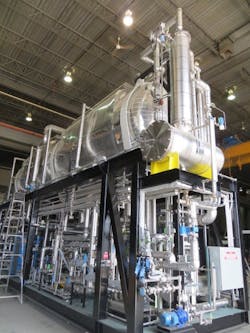Steam stripping as a means of scale prevention in industrial water treatment evaporators

One of the main challenges when treating industrial water in evaporators is the prevention of scale. Scaling is major reason for performance degradation and shutdowns.
In order to minimize waste, many industrial water treatment evaporators operate at high recoveries as a result of which the concentration of salts increases and reaches saturation level. The salts then precipitate.
Scaling of carbonate salts (especially calcium carbonate, CaCO3) is a common phenomenon in evaporators. CaCO3 is highly insoluble, and even a small presence of calcium and carbonate in the feed water might create scale.
Stripping is a process that prevents scaling of carbonate-based salts. Stripping is performed upstream of the evaporator, and removes carbonate from the feed water. Consequently, the calcium has no counter ion with which to precipitate, and scale will not be formed.
The process is divided into two steps:
- Shifting the carbonate to carbon dioxide (CO2).
- Removing CO2 from the water in a stripping tower.
The presence of the carbonate species (carbonate, bicarbonate and CO2) in the carbonate system depends on the pH. At high pH, the majority of the species appears as carbonate; at low pH the majority appears as CO2. Lowering the pH will shift Carbonate to CO2.
Further, the CO2 solubility is reduced and CO2 is released from the water. The CO2 solubility can be decreased in two ways:
- By increasing the temperature of the water — Preheating the water will reduce the CO2 solubility and will allow release of the CO2.
- The water is exposed to vacuum conditions and the partial pressure of the CO2 is reduced. As a result, the CO2 solubility decreases (Henry's law) and CO2 is released.
The exposure to vacuum conditions, and the removal of the CO2, is done in a vertical packed tower. Water is sprayed at the top and low pressure steam is injected at the bottom. In IDE evaporators, the steam is excess vapor from the evaporator. The flows are countercurrent, allowing maximum removal efficiency.
Stripping is economical in cases of feed water with low pH or low alkalinity. This type of water does not require a high consumption of acid, and the process requires only a packed tower and vacuum pump. Stripping was found to remove up to 90%-99% of the carbonate, which offers a solution for one of the major scaling issues in industrial evaporators.
IDE Technologies

